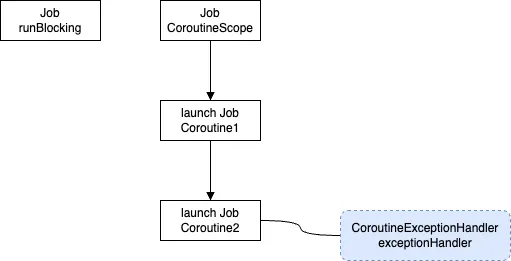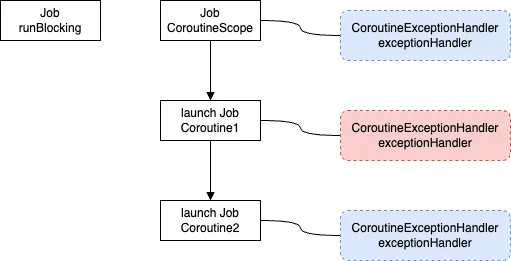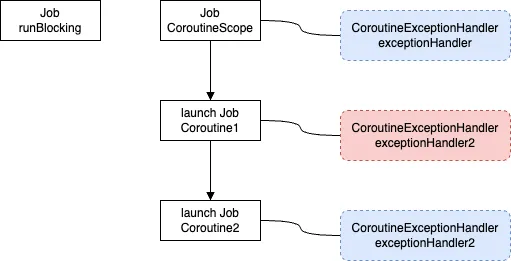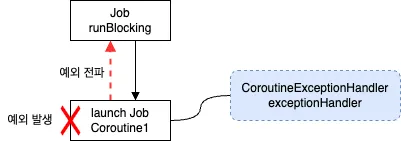Coroutine - 예외 처리(2): 예외 처리 방법
in DEV on Kotlin, Coroutine, Coroutine-exception-handler, Async, Cancellation-exception, Withtimeout, Job-cancellation-exception, Withtieoutornull
구조화된 동시성이라는 코루틴의 핵심 개념은 예외 전파 방식에 깊이 관여한다.
이 포스트에서는 아래 내용에 대해 알아본다.
- CoroutineExceptionHandler 를 활용한 예외 처리
- try-catch 로 예외 처리할 때 주의할 점
- 예외는 어디서 catch 해야 하는가?
async()로 만든 코루틴은 왜 try-catch 로 감싸도 예외를 잡지 못하는가?- 전파되지 않는 예외:
withContext()
소스는 github 에 있습니다.
목차
- 1.
CoroutineExceptionHandler()를 사용한 예외 처리 - 2. try-catch 문을 사용한 예외 처리
- 3.
async()의 예외 처리 - 4. 전파되지 않는 예외
- 참고 사이트 & 함께 보면 좋은 사이트
1. CoroutineExceptionHandler() 를 사용한 예외 처리
CoroutineExceptionHandler() 는 구조화된 코루틴 내에서 “최상위 launch 코루틴”의 공통 예외 처리기로 자주 사용된다.
CoroutineExceptionHandler 시그니처
public inline fun CoroutineExceptionHandler(
crossinline handler: (CoroutineContext, Throwable) -> Unit
): CoroutineExceptionHandler
CoroutineExceptionHandler()는 예외가 전파되었을 때 호출할 handler 를 람다식으로 받는다.- 이 handler 는 CoroutineContext, Throwable 타입의 매개변수를 갖는 람다식으로 이 람다식에 예외가 발생했을 때 어떤 동작을 할지 입력해 예외를 처리한다.
- 생성된 CoroutineExceptionHandler 객체는 CoroutineContext 객체의 구성 요소로 포함될 수 있어, launch 시점에 함께 전달하면 된다.
1.1. 처리되지 않은 예외만 처리
CoroutineExceptionHandler 객체는 처리되지 않은 예외(Uncaught Exception)만 처리한다.
즉, 자식 코루틴이 예외를 발생시켜 부모 코루틴으로 전파한 경우 자식 코루틴에서는 예외가 처리된 것으로 보아 자식에 설정한 예외 처리 핸들러는 동작하지 않는다.
자식 코루틴에 설정된 핸들러는 무시되는 예시
package chap08
import kotlinx.coroutines.CoroutineExceptionHandler
import kotlinx.coroutines.CoroutineName
import kotlinx.coroutines.CoroutineScope
import kotlinx.coroutines.Dispatchers
import kotlinx.coroutines.delay
import kotlinx.coroutines.launch
import kotlinx.coroutines.runBlocking
fun main() = runBlocking {
val exceptionHandler = CoroutineExceptionHandler { coroutineContext, throwable ->
println("Caught~~ [[$throwable]]")
}
CoroutineScope(context = Dispatchers.IO).launch(context = CoroutineName("Coroutine1")) {
launch(context = CoroutineName("Coroutine2") + exceptionHandler) { // CoroutineExceptionHandler 설정
throw Exception("코루틴 2에 예외 발생")
}
}
delay(1000L)
}
Exception in thread "DefaultDispatcher-worker-3" java.lang.Exception: 코루틴 2에 예외 발생
at chap08.Code10Kt$main$1$1$1.invokeSuspend(Code10.kt:17)
// ...
Process finished with exit code 0

위 코드에서 CoroutineExceptionHandler 는 동작하지 않는다.
- Coroutine2 는 Coroutine1 의 자식 코루틴이다.
- 예외는 Coroutine2 → Coroutine1 → 구조화된 상위 코루틴으로 전파된다.
- Coroutine2 의 exceptionHandler 는 예외를 처리한 것이 아니라 상위로 넘겼기 때문에 해당 예외 처리 핸들러는 동작하지 않는다.
구조화된 코루틴에서 여러 CoroutineExceptionHandler 객체가 설정되어 있어도 예외를 마지막으로 처리하는 위치에 설정된 CoroutineExceptionHandler 객체만 예외를 처리한다.
이런 특징 때문에 CoroutineExceptionHandler 객체는 ‘공통 예외 처리기’로서 동작할 수 있다.
예외 처리 핸들러는 이미 처리된(전파된) 예외에 대해서는 무시된다.
그렇다면 예외를 마지막으로 처리하는 위치는 어디일까? 바로 launch 함수로 생성된 코루틴 중 최상위에 있는 코루틴이다.
<CoroutineExceptionHandler 객체 정리>
- 처리 대상
- 처리되지 않은 예외(Uncaught Exception)
- 작동 위치
- launch 계열에서만 동작함 (async 는 해당 없음)
- 전파 여부
- 예외가 부모로 전파되면 자식의 핸들러는 무시됨
- 실제 적용 위치
- 최상위 launch 코루틴에 설정해야 함
즉, CoroutineExceptionHandler 는 launch 로 생성된 루트 코루틴의 컨텍스트에 등록해야 의미가 있다.
1.2. CoroutineExceptionHandler 의 동작 위치
CoroutineExceptionHandler 는 코루틴 계층에 여러 개가 설정되어 있더라도, 최상위 launch 코루틴에 설정된 에러 핸들러만 동작한다.
CoroutineScope 에 등록된 예외 처리 핸들러가 예외를 처리하는 예시
package chap08
import kotlinx.coroutines.CoroutineExceptionHandler
import kotlinx.coroutines.CoroutineName
import kotlinx.coroutines.CoroutineScope
import kotlinx.coroutines.delay
import kotlinx.coroutines.launch
import kotlinx.coroutines.runBlocking
fun main() = runBlocking<Unit> {
val exceptionHandler = CoroutineExceptionHandler { coroutineContext, throwable ->
println("Caught~~ [[$throwable]]")
}
CoroutineScope(context = exceptionHandler).launch(context = CoroutineName("Coroutine1")) {
launch(context = CoroutineName("Coroutine2")) {
throw Exception("코루틴 2에 예외 발생")
}
}
delay(1000L)
}
- CoroutineScope 의 컨텍스트에 설정한 exceptionHandler 가 Coroutine1 → Coroutine2 로 이어지는 예외 전파의 최상위에 존재함
- 따라서 Coroutine1 에서 예외를 처음으로 처리하며, 해당 예외 처리 핸들러가 동작함
CoroutineScope() 함수가 호출되면 기본적으로 Job 객체가 새로 생성되므로 runBlocking 이 호출되어 만들어지는 Job 객체와의 구조화가 깨지고, Coroutine1 코루틴은 CoroutineScope 객체로부터 CoroutineContext 를 상속받아 exceptionHandler 가 상속된다. Coroutine2 코루틴도 Coroutine1 코루틴으로부터 exceptionHandler 를 상속받아 아래와 같은 구조가 된다.

Caught~~ [[java.lang.Exception: 코루틴 2에 예외 발생]]
Process finished with exit code 0
Coroutine2 코루틴에서 발생한 예외가 exceptionHandler 에 의해 처리되어 예외 정보가 출력된 것을 확인할 수 있다.
exceptionHandler 는 CoroutineScope 객체, Coroutine 1,2 코루틴에도 모두 설정되어 있다. 그렇다면 셋 중 어디에 설정된 exceptionHandler 가 예외를 처리한 것일까?
바로 launch 함수로 생성된 코루틴 중 최상위에 있는 코루틴인 Coroutine1 코루틴이다.
위 그림에서 빨간색으로 표시된 launch 코루틴 중 최상위에 있는 Coroutine11 코루틴에 설정된 CoroutineExceptionHandler 객체만 동작해 예외가 출력된다.
이를 확인하기 위해 코드를 아래와 같이 바꿔보자.
예외 처리 핸들러를 각각 다른 위치에 설정한 예시
package chap08
import kotlinx.coroutines.CoroutineExceptionHandler
import kotlinx.coroutines.CoroutineName
import kotlinx.coroutines.CoroutineScope
import kotlinx.coroutines.Dispatchers
import kotlinx.coroutines.delay
import kotlinx.coroutines.launch
import kotlinx.coroutines.runBlocking
fun main() = runBlocking<Unit> {
val exceptionHandler = CoroutineExceptionHandler { coroutineContext, throwable ->
println("Caught 1~~ [[$throwable]]")
}
val exceptionHandler2 = CoroutineExceptionHandler { coroutineContext, throwable ->
println("Caught 2~~ [[$throwable]]")
}
CoroutineScope(context = Dispatchers.IO + exceptionHandler)
.launch(context = CoroutineName("Coroutine1") + exceptionHandler2) {
launch(context = CoroutineName("Coroutine2")) {
throw Exception("코루틴 2에 예외 발생")
}
}
delay(1000L)
}
Caught 2~~ [[java.lang.Exception: 코루틴 2에 예외 발생]]
Process finished with exit code 0

- 최상위 launch 코루틴인 Coroutine1 에 설정된 exceptionHandler2 가 실제로 예외를 처리함
- 그보다 상위인 CoroutineScope 의 예외 처리 핸들러인 exceptionHandler 는 무시됨
CoroutineExceptionHandler 는 launch 계열의 루트 코루틴에만 적용된다. (예외 로깅, 공통 에러 처리, 모니터링 로직은 최상위 예외 처리 핸들러에 넣어야 함)
따라서 async 에서는 무조건 await() + try-catch 로 예외를 처리해야 한다.
1.3. CoroutineExceptionHandler 를 사용해야 하는 경우
CoroutineExceptionHandler 의 handleException() 함수는 예외가 발생해 코루틴이 이미 완료된 상태에서 호출되기 때문에 예외 복구나 재시도에는 사용할 수 없다.
그렇다면 CoroutineExceptionHandler 는 언제 써야 할까?
CoroutineExceptionHandler 는 예외 발생 시 공통된 후처리 작업을 수행하기 위해 사용된다.
- 예외 로깅
- 사용자 알림
- 외부 모니터링 툴 연동
- 앱 전역 처리 로직 등
package chap08
import kotlinx.coroutines.CoroutineExceptionHandler
import kotlinx.coroutines.CoroutineName
import kotlinx.coroutines.CoroutineScope
import kotlinx.coroutines.Dispatchers
import kotlinx.coroutines.delay
import kotlinx.coroutines.launch
import kotlinx.coroutines.runBlocking
fun main() = runBlocking<Unit> {
val exceptionHandler: CoroutineExceptionHandler = CoroutineExceptionHandler { coroutineContext, throwable ->
println("예외 로깅~~ $throwable")
}
CoroutineScope(Dispatchers.IO)
.launch(context = CoroutineName("Coroutine1") + exceptionHandler) {
launch(context = CoroutineName("Coroutine2")) {
throw Exception("코루틴2에 예외 발생함")
}
launch(context = CoroutineName("Coroutine3")) {
delay(200L) // 이게 없으면 예외가 발생하기 전에 코루틴 3 이 실행됨. 코루틴 3 으로 예외 전파가 되는지 여부를 확인해보기 위해 넣어봄
println("코루틴 3 실행")
}
}
delay(1000L)
}
- 예외는 Coroutine2 에서 발생함
- 구조상 예외는 상위인 Coroutine1 으로 전파됨
- Coroutine1 에 설정된 exceptionHandler 가 공통 예외 핸들러 역할을 수행함
예외 로깅~~ java.lang.Exception: 코루틴2에 예외 발생함
Process finished with exit code 0

앱 전역 오류 처리가 필요한 경우 ViewModelScope, ApplicationScope 의 루트에 등록하여 사용한다.
네트워크 요청 등 실패가 허용되는 작업에는 SupervisorJob 과 함께 사용한다.
UI 앱이라면 Toast, Snackbar, Alert 등 사용자 알림 처리에 유용하다.
1.4. CoroutineExceptionHandler 는 예외 전파를 제한하지 않음
많은 개발자들이 CoroutineExceptionHandler 를 try-catch 처럼 예외를 ‘잡아서 흐름을 멈추는’ 기능으로 오해할 수 있다.
하지만 CoroutineExceptionHandler 는 예외를 ‘처리’는 해도 ‘전파를 막지는 않는다.’
CoroutineExceptionHandler 는 try-catch 문처럼 동작하지 않는다. 즉, 예외 전파를 제한하지 않는다. CoroutineExceptionHandler 는 예외가 마지막으로 처리되는 위치에서 예외를 처리할 뿐, 예외 전파를 제한하지 않는다.
package chap08
import kotlinx.coroutines.CoroutineExceptionHandler
import kotlinx.coroutines.CoroutineName
import kotlinx.coroutines.launch
import kotlinx.coroutines.runBlocking
fun main() = runBlocking<Unit> {
val exceptionHandler: CoroutineExceptionHandler = CoroutineExceptionHandler { coroutineContext, throwable ->
println("Caught~ $throwable")
}
launch(context = CoroutineName("Coroutine1") + exceptionHandler) {
throw Exception("예외가 발생함")
}
}
- Coroutine1 코루틴에서 예외가 발생한다.
- runBlocking 의 자식 launch 코루틴에서 예외가 발생하면 예외가 runBlocking 까지 전파되어 프로그램이 종료된다.
CoroutineExceptionHandler 는 루트 코루틴(부모가 없는 launch) 에서만 동작한다.
위 코드에서 Coroutine1 은 runBlocking 의 자식으로 루트가 아니므로 예외가 전파되어 runBlocking 을 종료시키고, 프로세스가 비정상 종료된다.
결과를 보면 예외가 전파되어 프로세스가 비정상 종료된 것을 확인할 수 있다. (exit code 1 로 종료됨)
Exception in thread "main" java.lang.Exception: 예외가 발생함
// ...
Process finished with exit code 1

❗️ 아래 상황에서는 CoroutineExceptionHandler 가 동작하지 않는다.
launch()가 runBlocking 의 자식일 때async()를 사용할 때- 이 때는 try-catch 또는 SupervisorJob + launch 패턴을 사용해야 함
2. try-catch 문을 사용한 예외 처리
CoroutineExceptionHandler 는 처리되지 않은 예외에 대해서만 동작하지만, try-catch 는 예외가 발생한 지점에서 즉시 처리할 수 있다.
따라서 try-catch 는 정밀한 예외 복구, 로직 분기 등에 사용된다.
package chap08
import kotlinx.coroutines.CoroutineName
import kotlinx.coroutines.delay
import kotlinx.coroutines.launch
import kotlinx.coroutines.runBlocking
fun main() = runBlocking<Unit> {
launch(context = CoroutineName("Coroutine1")) {
try {
throw Exception("Coroutine1 에서 예외 발생")
} catch(e: Exception) {
println(e.message)
}
}
launch(context = CoroutineName("Coroutine2")) {
delay(100L)
println("Coroutine2 실행")
}
}

Coroutine1 에서 예외 발생
Coroutine2 실행
Process finished with exit code 0
- Coroutine1 에서 예외가 발생했지만 try-catch 문으로 즉시 처리되어 상위 코루틴인 runBlocking 으로 예외가 전파되지 않음
- 따라서 Coroutine2 는 영향을 받지 않고 정상적으로 실행됨
- CoroutineExceptionHandler 와는 달리, try-catch 는 예외 목구 및 제어 흐름 유지가 가능함
⚠️ 주의할 점!
launch()와는 달리async()에서 발생한 예외는await()호출 시 발생하므로 try-catch 는await()로 감싸야 한다.- 구조화된 코루틴에서 try-catch 로 하위 코루틴의 예외를 감싸더라도, 부모 코루틴이 함께 취소되는 문제는 SupervisorJob 없이는 막을 수 없다.
2.1. 코루틴 빌더 함수에 대한 try-catch 문은 예외를 잡지 못함
try-catch 문 사용 시 많이 하는 실수는 코루틴 빌더 함수(launch(), async()) 자체를 try-catch 문으로 감싸는 것이다.
하지만 그렇게 하면 코루틴 내부에서 발생하는 예외는 잡히지 않는다.
코루틴 빌더를 try-catch 문으로 감싸는 잘못된 예외 처리 방식의 예시
package chap08
import kotlinx.coroutines.CoroutineName
import kotlinx.coroutines.delay
import kotlinx.coroutines.launch
import kotlinx.coroutines.runBlocking
fun main() = runBlocking<Unit> {
try {
launch(context = CoroutineName("Coroutine1")) {
throw Exception("코루틴 1 에서 예외 발생")
}
} catch (e: Exception) {
println(e.message)
}
launch(context = CoroutineName("Coroutine2")) {
delay(100L)
println("코루틴2 실행")
}
}
launch()는 코루틴을 생성만 하고, 실제 코드는 별도의 스레드에서 비동기로 실행됨- 따라서 try-catch 는
launch()함수 자체의 예외만 감지할 수 있을 뿐, 코루틴 블록 내부에서 발생한 예외는 잡지 못함 - 결과적으로 Coroutine1 에서 발생한 예외는 상위인 runBlocking 까지 전파되고, 그 결과 전체 프로그램은 비정상 종료(exit code 1) 된다.
코루틴에 대한 예외 처리 시에는 코루틴 빌더 함수의 람다식 내부에서 try-catch 문을 사용해야 한다.
Exception in thread "main" java.lang.Exception: 코루틴 1 에서 예외 발생
// ...
Process finished with exit code 1 // 프로그램이 비정상 종료됨(exit code 1)
3. async() 의 예외 처리
async() 는 비동기 연산의 결과를 Deferred<T> 객체로 감싸서 반환한다.
따라서 코루틴 블록 내부에서 예외가 발생해도 그 즉시 예외가 노출되지 않고, await() 호출 시점에 예외가 노출된다.
async() 코루틴 빌더 함수 사용 시엔 반드시 await() 호출부에서 try-catch 문을 감싸야 한다.
package chap08
import kotlinx.coroutines.CoroutineName
import kotlinx.coroutines.Deferred
import kotlinx.coroutines.async
import kotlinx.coroutines.runBlocking
import kotlinx.coroutines.supervisorScope
fun main() = runBlocking<Unit> {
supervisorScope {
val deferred: Deferred<String> = async(context = CoroutineName("Coroutine1")) {
throw Exception("코루틴1 예외 발생")
}
try {
deferred.await()
} catch (e: Exception) {
println("예외 잡음~ ${e.message}")
}
}
}
- 예외는
await()시점에 발생하고, try-catch 로 안전하게 처리됨 - supervisorScope 덕분에 예외가 상위 코루틴으로 전파되지 않음
예외 잡음~ 코루틴1 예외 발생
Process finished with exit code 0
만일 supervisorScope 가 없다면 아래처럼 예외는 처리되지만, runBlocking 으로 예외가 전파되어 프로그램이 비정상 종료된다.
예외 잡음~ 코루틴1 예외 발생
Exception in thread "main" java.lang.Exception: 코루틴1 예외 발생
// ...
Process finished with exit code 1 // 비정상 종료(exit code 1)
3.1. async() 의 예외 전파: await() 없이도 예외는 전파됨
async() 도 예외 발생 시 부모에게 예외를 전파한다.
많은 개발자들이 async() 사용 시 예외가 await() 를 호출해야만 노출된다고 생각하지만 예외는 항상 부모 코루틴에게 전파된다.
예외 전파를 고려하지 않은 async() 의 잘못된 사용 예시
package chap08
import kotlinx.coroutines.CoroutineName
import kotlinx.coroutines.async
import kotlinx.coroutines.delay
import kotlinx.coroutines.launch
import kotlinx.coroutines.runBlocking
fun main() = runBlocking<Unit>{
async(context = CoroutineName("Coroutine1")) {
throw Exception("Coroutine1 에서 예외 발생")
}
launch(context = CoroutineName("Coroutine2")) {
delay(100L)
println("[${Thread.currentThread().name}] 코루틴 실행")
}
}
await()를 호출하지 않았음에도 예외 발생- Coroutine1 에서 발생한 예외가 runBlocking 으로 전파
- 부모 코루틴이 취소되면서 자식 코루틴인 Coroutine2 도 실행되지 않음
Exception in thread "main" java.lang.Exception: Coroutine1 에서 예외 발생
// ...
Process finished with exit code 1
이를 해결하기 위해서는 코루틴1 에서 발생한 예외가 부모 코루틴으로 전파되지 않도록 supervisorScope 를 사용하여 예외 전파를 제한시키면 된다.
package chap08
import kotlinx.coroutines.CoroutineName
import kotlinx.coroutines.async
import kotlinx.coroutines.delay
import kotlinx.coroutines.launch
import kotlinx.coroutines.runBlocking
import kotlinx.coroutines.supervisorScope
fun main() = runBlocking<Unit> {
supervisorScope {
async(context = CoroutineName("Coroutine1")) {
throw Exception("Coroutine1 에서 예외 발생")
}
launch(context = CoroutineName("Coroutine2")) {
delay(100L)
println("[${Thread.currentThread().name}] 코루틴 실행")
}
}
}
[main @Coroutine2#3] 코루틴 실행
Process finished with exit code 0
- Coroutine1 의 예외는 Coroutine2 에 영향을 주지 않음
- supervisorScope 덕분에 자식 코루틴 간 예외 전파 차단
⚠️ 주의할 점
async()는 예외가 발생하면 부모 코루틴을 즉시 취소시킨다.await()호출 여부와는 무관하게 예외는 즉시 전파된다.- 따라서 예외 전파를 막고 싶다면 supervisorScope 로 감싸야 한다.
async() 코루틴 빌더를 사용할 때는 전파되는 예외와 await 호출 시 노출되는 예외를 모두 처리해주어야 한다.
3.2. async() 와 launch() 의 예외 처리
| 구분 | launch() | async() |
|---|---|---|
| 반환값 | Job (결과 없음) | Deferred<T> (결과 있음) |
| 예외 전파 시점 | 즉시 전파됨 | await() 호출 시점에 전파됨 |
| 예외 처리 | 코루틴 내부에서 try-catch 또는 CoroutineExceptionHandler | await() 를 try-catch 로 감싸야 함 |
4. 전파되지 않는 예외
4.1. 전파되지 않는 예외, CancellationException
CancellationException 는 코루틴의 취소를 나타내는 특별한 예외이기 때문에 내부적으로 취소 플래그로만 동작하고 다른 코루틴에는 영향을 주지 않는다.
즉, CancellationException 은 부모에게 예외를 전파하지 않는다.
package chap08
import kotlinx.coroutines.CancellationException
import kotlinx.coroutines.CoroutineName
import kotlinx.coroutines.delay
import kotlinx.coroutines.launch
import kotlinx.coroutines.runBlocking
fun main() = runBlocking<Unit>(context = CoroutineName("runBlocking 코루틴")) {
launch(context = CoroutineName("Coroutine1")) {
launch(context = CoroutineName("Coroutine2")) {
throw CancellationException()
}
delay(100L)
println("[${Thread.currentThread().name}] 코루틴 실행")
}
delay(100L)
println("[${Thread.currentThread().name}] 코루틴 실행")
}
- Coroutine2 에서
CancellationException이 발생 - 하지만
CancellationException는 코루틴 자체를 취소하는 용도이므로 예외가 부모 코루틴으로 전파되지 않음 - Coroutine2 만 종료되고, 나머지 코루틴은 정상 실행
만일 Coroutine2 코루틴에서 발생한 예외가 Exception, RuntimeException 이었다면 예외가 부모로 전파되어 구조화된 코루틴 전체가 취소되었을 것ㅇ다.
[main @runBlocking 코루틴#1] 코루틴 실행
[main @Coroutine1#2] 코루틴 실행
Process finished with exit code 0

4.2. 코루틴 취소 시 사용되는 JobCancellationException
CancellationException 은 취소 신호로 사용된다.
코틀린 코루틴은 CancellationException (혹은 그 하위 클래스인 JobCancellationException) 내부적으로 코루틴 취소의 시그널로 사용한다.
이는 일반적인 예외 처리와는 목적이 다르며 부모 코루틴으로 전파되지 않고 해당 코루틴만 종료시키는 특성을 가진다.
코루틴 취소 시 JobCancellationException 확인하는 예시
package chap08
import kotlinx.coroutines.Job
import kotlinx.coroutines.delay
import kotlinx.coroutines.launch
import kotlinx.coroutines.runBlocking
fun main() = runBlocking<Unit> {
val job: Job = launch {
delay(1000L)
}
job.invokeOnCompletion { e ->
println("--- ${e}") // 발생한 예외 출력
}
job.cancel() // job 취소
}
- job.cancel() 호출 → 내부적으로
JobCancellationException발생 - 해당 코루틴은 정상적으로 종료된 것처럼 간주됨 (해당 Job(코루틴) 취소)
invokeOnCompletion()을 사용하면 코루틴 종료 사유를 콜백으로 받아 종료 사유를 로깅할 수 있으며, 이 때 발생한 예외가JobCancellationException임을 확인 가능
--- kotlinx.coroutines.JobCancellationException: StandaloneCoroutine was cancelled; job=StandaloneCoroutine{Cancelled}@71bc1ae4
Process finished with exit code 0
JobCancellationException 은 전파되지 않는다.
- 일반 예외(Exception, RuntimeException) 과는 다르게
JobCancellationException은 부모나 형제 코루틴을 취소하지 않는다.
4.3. withTimeOut() 을 사용해 코루틴의 실행 시간 제한
withTimeOut() 함수는 코루틴 실행 시간을 제한할 수 있다.
withTimeOut() 함수는 특정 시간이 초과되면 작업을 강제로 중단시키고, TimeoutCancellationException 을 발생시켜 해당 코루틴만 취소한다.
이 예외는 CacellationException 의 하위 클래스이므로 부모 코루틴으로 전파되지 않으며, 프로그램 종료없이 안전하게 사용 가능하다.
withTimeOut() 시그니처
public suspend fun <T> withTimeout(timeMillis: Long, block: suspend CoroutineScope.() -> T): T
- timeMillis
- 제한 시간(ms)
- block
- 실행할 suspend 함수 블록
package chap08
import kotlinx.coroutines.CoroutineName
import kotlinx.coroutines.delay
import kotlinx.coroutines.launch
import kotlinx.coroutines.runBlocking
import kotlinx.coroutines.withTimeout
fun main() = runBlocking<Unit>(CoroutineName("Parent")) {
launch(context = CoroutineName("Child")) {
withTimeout(1000L) { // 실행 시간을 1초로 제한
delay(2000L) // 2초 걸리는 작업
println("[${Thread.currentThread().name}] 코루틴 실행11")
}
}
delay(2000L)
println("[${Thread.currentThread().name}] 코루틴 실행22")
}
[main @Parent#1] 코루틴 실행22
Process finished with exit code 0
- Child 코루틴은 2초 동안 대기하려 했지만 withTimeout(1000L) 으로 인ㅇ해 1초 후
TimeoutCancellationException발생 - 이 예외는 부모 코루틴으로 전파되지 않기 때문에 Parent 코루틴은 영향을 받지 않고 정상 실행됨
TimeoutCancellationException은CancellationException의 하위 클래스이므로 취소만 유도하고 예외 전파는 하지 않음
withTimeOut() 사용 시엔 반드시 예외를 try-catch 로 잡거나, 취소 로직을 처리해야 안전한 종료가 가능하다.
withTimeOut() 에 설정된 제한 시간을 초과하면 지연되던 블록은 즉시 취소된다.
TimeoutCancellationException 을 catch 하여 타임아웃 시 예외 메시지를 별도로 처리할 수 있다.
withTimeOut() 함수는 실행 시간이 제한되어야 할 필요가 있는 네트워크 호출의 실행 시간 제한, IO 작업, 사용자 입력 제한 등에 사용된다.
4.3.1. withTimeOut() 의 try-catch
package chap08
import kotlinx.coroutines.CoroutineName
import kotlinx.coroutines.delay
import kotlinx.coroutines.runBlocking
import kotlinx.coroutines.withTimeout
fun main() = runBlocking<Unit>(context = CoroutineName("Parent")) {
try {
withTimeout(2000L) {
delay(2000L) // 2초의 작업이 걸리는 작업
println("[${Thread.currentThread().name}] 코루틴 실행")
}
} catch (e: Exception) {
println("e: ${e}")
}
}
e: kotlinx.coroutines.TimeoutCancellationException: Timed out waiting for 2000 ms
Process finished with exit code 0
결과를 보면 withTimeOut() 에서 발생한 예외가 catch 문에 잡혀 로그가 출력되는 것을 확인할 수 있다.
4.3.2. withTimeOutOrNull()
withTimeOut() 은 예외를 던지지만, withTimeOutOrNull() 은 null 을 반환한다.
withTimeOutOrNull() 은 withTimeOut() 과 동일하게 작업 시간 제한을 두되, 시간이 초과될 경우 TimeoutCancellationException 을 던지지 않고 null 을 반환한다.
이로 인해 예외 처리 없이도 안전하게 timeout 상황을 감지할 수 있다.
package chap08
import kotlinx.coroutines.CoroutineName
import kotlinx.coroutines.delay
import kotlinx.coroutines.launch
import kotlinx.coroutines.runBlocking
import kotlinx.coroutines.withTimeoutOrNull
fun main() = runBlocking<Unit>(context = CoroutineName("Parent")) {
launch(context = CoroutineName("Coroutine")) {
val result: String? = withTimeoutOrNull(1000L) { // 실행 시간을 1초로 제한
delay(2000L) // 2초의 시간이 걸리는 작업
return@withTimeoutOrNull "결과"
}
println("result: $result")
}
}
result: null
Process finished with exit code 0
- delay(2000L) 로 작업은 제한 시간 1초를 초과함
withTimeOutOrNull()은 예외를 던지지 않고 null 반환- 예외 없이 null 을 출력하고 정상 종료됨
withTimeOutOrNull() 은 아래와 같은 상황에 사용된다.
- 예외 발생 없이 timeout 을 처리하고 싶은 경우
- 타임아웃 여부만으로 분기 처리를 하고 싶은 경우
- 예) 캐시 조회 또는 외부 서비스 호출 실패 시 fallback 처리 등
참고 사이트 & 함께 보면 좋은 사이트
본 포스트는 조세영 저자의 코틀린 코루틴의 정석을 기반으로 스터디하며 정리한 내용들입니다.
